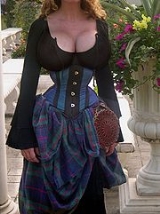
Tightlacing
Encyclopedia

Corset
A corset is a garment worn to hold and shape the torso into a desired shape for aesthetic or medical purposes...
to achieve extreme modifications to the figure and posture and experience the sensations of a very tight corset. Those who practice tightlacing are called tightlacer
Tightlacer
A tightlacer is someone who practises daily tightlacing; the wearing of a corset for long periods in order to reduce the natural circumference of the waist....
s. Some tightlacers call the corsets they wear training corset
Training corset
A training corset is generally a corset used in body modification. A training corset may be used for orthopedic reasons or for cosmetic reasons The term "training corset" is also sometimes used for BDSM corsets used for discipline.In addition, the...
s.
Description
The most frequent aim of tightlacing is a slim waist. Depending on the silhouette desired, the shape of the ribcage may be altered as well. Wearing a corset can also change the bustline, by raising the breasts upwards and shaping them, flattening the stomach, and improving posture. However, these effects are only temporary and will be lost on removing the corset. Indeed, excessive corset wearing has been claimed to weaken certain muscles, making it more difficult to maintain posture without a corset.Although some tightlacers aim to get their waists as small as possible, others prefer to reduce their waists to a certain point and go no further as they consider that proportion and aesthetics are more important than achieving the smallest possible measurement. For example, cross-dressing males may seek to make a more feminine-appearing waistline through tightlacing, but do not want to make their waists too small, as this would look unnatural.
History of tightlacing
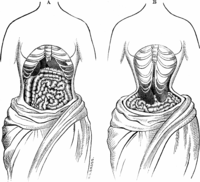
Corset
A corset is a garment worn to hold and shape the torso into a desired shape for aesthetic or medical purposes...
s were first worn by the Minoans of Crete
Crete
Crete is the largest and most populous of the Greek islands, the fifth largest island in the Mediterranean Sea, and one of the thirteen administrative regions of Greece. It forms a significant part of the economy and cultural heritage of Greece while retaining its own local cultural traits...
by both men and women, but didn't become popular again until during the 16th century and remained a feature of fashionable dress until the French Revolution
French Revolution
The French Revolution , sometimes distinguished as the 'Great French Revolution' , was a period of radical social and political upheaval in France and Europe. The absolute monarchy that had ruled France for centuries collapsed in three years...
(1789). These corsets were mainly designed to turn the torso into the fashionable cylindrical shape although they narrowed the waist as well. They had shoulder straps; they ended at the waist; they flattened the bust and, in so doing, pushed the breasts up. The emphasis of the corset was less on the smallness of the waist than on the contrast between the rigid flatness of the bodice front and the curving tops of the breasts peeking over the top of the corset. There are no records of tightlacers at this time.
The corset then went into eclipse. Fashion embraced the Empire silhouette
Empire silhouette
An Empire silhouette is created by a woman wearing a high-waisted dress, gathered near or just under the bust with a long, loose skirt, which skims the body. The outline is especially flattering to pear shapes wishing to disguise the stomach area or emphasise the bust. The shape of the dress also...
: a Graeco-Roman style, with the high-waisted dress that was unique to this style gathered under the bosom. The waist was de-emphasised, and dresses were sewn from thin muslins rather than the heavy brocades and satins of aristocratic high fashion.
The reign of the Empire waist was short. In the 1830s, shoulders widened (with puffy gigot sleeves or flounces), skirts widened (layers of stiffened petticoats), and the waist narrowed and migrated towards its "natural" position. By the 1850s
1850s in fashion
1850s fashion in Western and Western-influenced clothing is characterized by an increase in the width of women's skirts supported by crinolines or hoops, and the beginnings of dress reform.-Gowns:...
, exaggerated shoulders were out of fashion and waistlines were cinched at the natural waist above a wide skirt. Fashion had achieved what is now known as the Victorian
Victorian fashion
Victorian fashion comprises the various fashions and trends in British culture that emerged and grew in province throughout the Victorian era and the reign of Queen Victoria, a period which would last from June 1837 to January 1901. Covering nearly two thirds of the 19th century, the 63 year reign...
silhouette.
In the 1830s, the artificially inflated shoulders and skirts
1830s and 1840s in fashion
1830s fashion in European and European-influenced clothing is characterized by an emphasis on breadth, initially at the shoulder and later in the hips, in contrast to the narrower silhouettes that had predominated between 1800 and the 1820s....
made the intervening waist look narrow, even with the corset laced only moderately. When the exaggerated shoulders disappeared, the waist itself had to be cinched tightly in order to achieve the same effect. It is in the 1840s and 1850s that tightlacing is first recorded. It was ordinary fashion taken to an extreme.
As it was accepted that a corseted waist was the ideal, it is hard to define tightlacing strictly, or to say what proportion of Victorian women practiced it. Today's waist measurements are unacceptable as a guide, since:
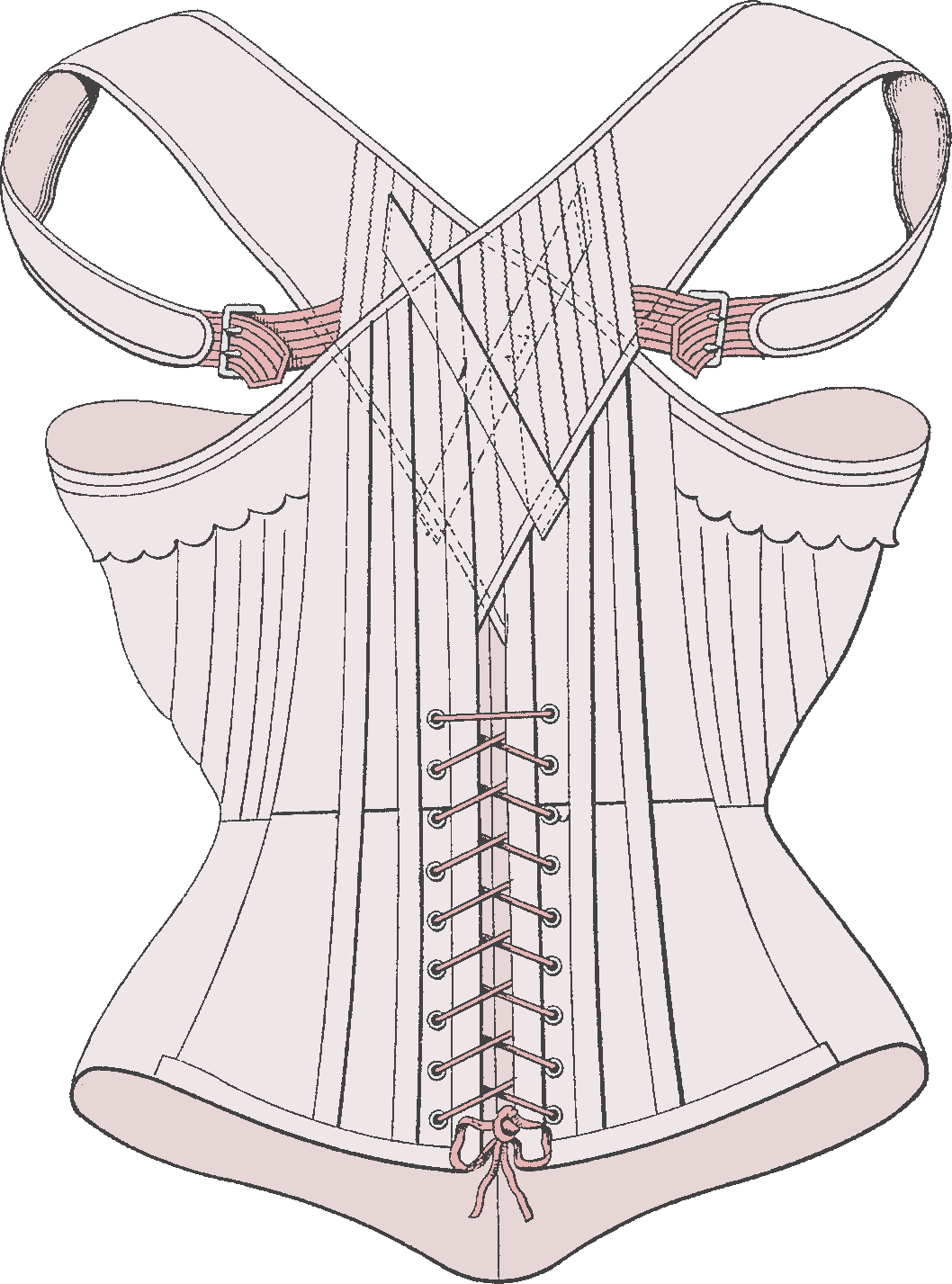
- Women's bodies have increased in size since the nineteenth century, so waist measurements that seem small today might not have been considered so by Victorians.
- As corset wearing was the norm in the nineteenth century, it is likely that women tolerated proportionally greater reductions as a matter of course, without thinking of themselves as tightlacers.
Young and fashionable women were most likely to tightlace, especially for balls, fashionable gatherings, and like occasions for display. Older, poorer, and primmer women would have laced moderately – just enough to be decent.
The Victorian and Edwardian corset differed from earlier corsets in numerous ways. The corset no longer ended at the waist, but flared out and ended several inches below the waist. The corset was exaggeratedly curvaceous rather than cylindrical. It was also much sturdier in construction, thanks to improvements in technology. Spiral steel stays curved with the figure rather than dictating a cylindrical silhouette. While many corsets were still sewn by hand to the wearer's measurements, there was also a thriving market in cheaper mass-produced corsets.
In the late years of the Victorian era
Victorian era
The Victorian era of British history was the period of Queen Victoria's reign from 20 June 1837 until her death on 22 January 1901. It was a long period of peace, prosperity, refined sensibilities and national self-confidence...
, medical reports and rumors claimed that tightlacing was fatally detrimental to health (see Victorian dress reform
Victorian dress reform
During the middle and late Victorian period, various reformers proposed, designed, and wore clothing supposedly more rational and comfortable than the fashions of the time. This was known as the dress reform or rational dress movement...
). Women who suffered to achieve small waists were also condemned for their vanity and excoriated from the pulpit as slaves to fashion. It was frequently claimed that too small a waist was ugly rather than beautiful. Dress reformers exhorted women to abandon the tyranny of stays and free their waists for work and healthy exercise.
Coinciding with the popularity of corset training during the 16th, 17th, and 19th centuries was the popularity of corset punishment which was used as a method to control the wearer who would be unable to run, breath heavily, or eat too much while tightlaced.
Despite the efforts of dress reformers to eliminate the corset, and despite medical and clerical warnings, women persisted in tightlacing as long as it was fashionable. In the early 1900s, the small corseted waist began to fall out of fashion. The feminist and dress reform movements had made practical clothing acceptable for work or exercise. The rise of the Artistic Dress movement
Artistic Dress movement
The Artistic Dress movement and its successor, Aesthetic Dress, were fashion trends in nineteenth century clothing that rejected the highly structured and heavily trimmed Paris fashion of the day in favour of beautiful materials and simplicity of design....
made loose clothing and the natural waist fashionable even for evening wear. Couturiers like Fortuny
Fortuny
Fortuny is a surname of Catalan origin. It may refer to:* Enzo Fortuny, Mexican voice actor* Jason Fortuny, creator of an internet hoax* Mariano Fortuny , Spanish painter...
and Poiret
Poiret
Poiret may refer to several people:*Jean Poiret, author of La Cage aux Folles*Jean Louis Marie Poiret, French botanist*Jean Louis Georges Poiret*Paul Poiret, fashion designer...
designed exotic, alluring costumes in pleated or draped silks, calculated to reveal slim, youthful bodies. If one didn't have such a body, new undergarments, the brassiere
Brassiere
A brassiere is an undergarment that covers, supports, and elevates the breasts. Since the late 19th century, it has replaced the corset as the most widely accepted method for supporting breasts....
and the girdle
Girdle
A girdle is a garment that encircles the lower torso, perhaps extending below the hips, and worn often for support. The word girdle originally meant a belt. In modern English, the term girdle is most commonly used for a form of women's foundation wear that replaced the corset in popularity...
, promised to give the illusion of one.
Corsets were no longer fashionable, but some people still felt that they were sexy. Corsets entered the underworld of the fetish
Sexual fetishism
Sexual fetishism, or erotic fetishism, is the sexual arousal a person receives from a physical object, or from a specific situation. The object or situation of interest is called the fetish, the person a fetishist who has a fetish for that object/situation. Sexual fetishism may be regarded, e.g...
, along with items such as bondage
Bondage (BDSM)
Bondage is the use of restraints for the sexual pleasure of the parties involved. It may be used in its own right, as in the case of rope bondage and breast bondage, or as part of sexual activity or BDSM activity.- Private bondage :...
gear and vinyl catsuit
Catsuit
A catsuit is a close-fitting one-piece garment that covers the torso and the legs, and frequently the arms. They are usually made from stretchable material, such as lycra, chiffon, spandex , leather, latex, PVC, or velour, and frequently close using a zipper at the front or back.Catsuits, which...
s. In the 1960s, 1970s, 1980s and 1990s, fetish wear became a fashion trend and corsets made something of a recovery. They are often worn as top garments rather than underwear. However, most corset wearers own a bustier
Bustier
A bustier is a form-fitting garment for women, which is traditionally worn as lingerie. Its primary purpose is to push up the bust by tightening against the upper midriff and forcing the breasts up, while gently shaping the waist. Nowadays, it might also be worn as a push-up bra under a low-backed...
or two for evening wear; they do not tightlace. Historical re-enactors also wear corsets, but few tightlace.
Tightlacing today
Modern tightlacing is a minority interest, often associated with fetishistic interestSexual fetishism
Sexual fetishism, or erotic fetishism, is the sexual arousal a person receives from a physical object, or from a specific situation. The object or situation of interest is called the fetish, the person a fetishist who has a fetish for that object/situation. Sexual fetishism may be regarded, e.g...
in the corset and BDSM
BDSM
BDSM is an erotic preference and a form of sexual expression involving the consensual use of restraint, intense sensory stimulation, and fantasy power role-play. The compound acronym BDSM is derived from the terms bondage and discipline , dominance and submission , and sadism and masochism...
. The majority of tightlacers are women, although some men also tightlace extensively.
Tightlacers typically wear a corset for at least 12 hours a day, every day, when they are most active, although more serious tightlacers (particularly those trying to achieve the smallest waist they can) wear corsets for up to 23 hours a day, taking the corset off only in order to bathe.
Tightlacers sometimes have a partner, called a trainer, to help and support them. However, it is possible for somebody to tightlace without a partner.
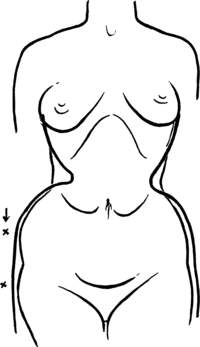
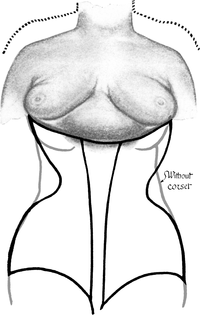
Effects
A typical training routine begins with the use of a well-fitted corset (most serious tightlacers have at least one custom-tailored corset) and very gradual decreases in the waist circumference. Lacing too tight too fast can cause extreme discomfort and potential short-term problems such as shortness of breath and faintness, indigestion, and chafing of the skin.The primary effect of tightlacing is the decreased size of the waist. The smallest waist recorded is that of Ethel Granger, who tightlaced for most of her life and achieved a waist of 13 inches (33 cm): a reduction of over ten inches. Such extreme reductions take a very long time to achieve. At first, corsets with waist measurements four inches smaller than the tightlacer's natural waist size are recommended. The length of time it will take a tightlacer to get used to this reduction will vary on his or her physiology; a large amount of fat on the torso and strong abdominal muscles will mean that it takes longer for the tightlacer to wear their corset laced closed at the back. Thereafter, reducing another couple of inches is not much more difficult, but each inch after a six-inch reduction can take a year to achieve.
The diminished waist and tight corset reduce the volume of the torso. This is sometimes reduced even further by styles of corset that force the torso to taper towards the waist, which pushes the lower ribs inwards. As a consequence, internal organs are moved closer together and out of their original positions in a way similar to the way that a pregnant woman's expanding uterus
Uterus
The uterus or womb is a major female hormone-responsive reproductive sex organ of most mammals including humans. One end, the cervix, opens into the vagina, while the other is connected to one or both fallopian tubes, depending on the species...
causes the organs to be displaced.
The volume of the lungs diminishes and the tightlacer tends to breathe intercostally – that is, with the upper portion of the lungs only, rather than the whole (see shallow breathing
Shallow breathing
Shallow breathing, thoracic breathing, or chest breathing is the drawing of minimal breath into the lungs, usually by drawing air into the chest area using the intercostal muscles rather than throughout the lungs via the diaphragm. Shallow breathing can result in or be symptomatic of rapid...
). Intercostal breathing is what gives the image of "heaving bosoms". Due to the lower portion of the lungs being used less there is often a mucosal build-up there; a slight and persistent cough is the sign of the body trying to clear this (and might also have led to the Victorian hypothesis that corsets caused tuberculosis
Tuberculosis
Tuberculosis, MTB, or TB is a common, and in many cases lethal, infectious disease caused by various strains of mycobacteria, usually Mycobacterium tuberculosis. Tuberculosis usually attacks the lungs but can also affect other parts of the body...
).
The liver
Liver
The liver is a vital organ present in vertebrates and some other animals. It has a wide range of functions, including detoxification, protein synthesis, and production of biochemicals necessary for digestion...
is pressed upwards. As it continually renews itself, it adapts to fit its new position, and in a long-term tightlacer it can develop ridges where it rests against the ribs. It is also possible that tightlacing exacerbates the tendency of some livers to develop accessory lobes, to the point where the accessory lobe becomes as large as the main portion of the liver. The point where the lobe and liver connect can be quite thin, and again, this might have led to one of the Victorian myths about tightlacing: that a tightlacer can wear her corset so tight that it "cuts" her liver in half.
The compression of the stomach
Stomach
The stomach is a muscular, hollow, dilated part of the alimentary canal which functions as an important organ of the digestive tract in some animals, including vertebrates, echinoderms, insects , and molluscs. It is involved in the second phase of digestion, following mastication .The stomach is...
reduces its volume, and tightlacers find that eating too much gives them indigestion and heartburn; foods like carbonated drinks and beans can easily cause trapped wind. The compression of the intestines can cause constipation. Many tightlacers will alter their diet in order to avoid these problems.
Theoretically it is possible to fracture the ribs through tightlacing, but the necessary pressure would be brutal and the tightlacer would feel acute pain.
See also
- Body dysmorphic disorderBody dysmorphic disorderBody Dysmorphic Disorder is a type of mental illness, a somatoform disorder, wherein the affected person is exclusively concerned with body image, manifested as excessive concern about and preoccupation with a perceived defect of his or her physical features...
- Body modificationBody modificationBody modification is the deliberate altering of the human body for any non-medical reason, such as aesthetics, sexual enhancement, a rite of passage, religious reasons, to display group membership or affiliation, to create body art, shock value, or self expression...
- CorsetCorsetA corset is a garment worn to hold and shape the torso into a desired shape for aesthetic or medical purposes...
- Corset controversyCorset controversyThe corset controversy is an ensemble of letters and articles concerning the corset that appeared in newspapers and periodicals in the 19th century.-Introduction:...
- PolairePolairePolaire was the stage name used by French singer and actress Émilie Marie Bouchaud .Born at Agha, Algiers, Algeria, according to her memoirs she was one of eleven children of whom only four - Emilie, her two brothers Edmond and Marcel, and a sister, Lucile - survived infancy...
- Victorian dress reformVictorian dress reformDuring the middle and late Victorian period, various reformers proposed, designed, and wore clothing supposedly more rational and comfortable than the fashions of the time. This was known as the dress reform or rational dress movement...
External links
- Staylace.com, the website of the Long Island Staylace Association (LISA) has some further information on the medical considerations and effects of tightlacing.
Against tightlacing
- Tight-lacing
- THE CORSET, questions of pressure and displacement. A medical report from 1887.
- The Corset Controversy
- Binding Femininity:
an Examination Of The Effects Of tightlacing On The Female Pelvis. A Thesis

